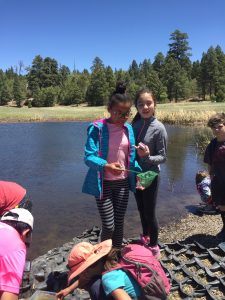Bio Blitz at Marshall Lake

On May 22nd, 2018, 38 students from Flagstaff Junior Academy visited Marshall Lake at the intersection of the Walnut Canyon and Anderson Mesa passages on the Arizona Trail. The goal of the day was to conduct a “bioblitz” on the plants and animals we could find in the area and upload our findings to iNaturalist, an app where citizen scientists can add to the database of known species in a given area.
A bioblitz is a super fun way to teach and reinforce taxonomy, the use of dichotomous keys, keen observation skills, and address the importance of biodiversity in an ecosystem. With the help of teachers and volunteers from Northern Arizona University, students keyed out grasses and other herbaceous plants, trees, insects, birds, and aquatic macroinvertebrates. The project yielded 66 observations uploaded to iNaturalist over the course of our bioblitz! Putting these observations into the database increases scientific knowledge and serves our community.
After making observations, students had an opportunity to compare their findings of aquatic macroinvertebrates to a benthic bug assessment chart. Benthic bugs are particular species of invertebrates that are highly or moderately susceptible to pollution. When these “canaries” are present it is one indicator of a healthy ecosystem. If only highly pollution tolerant species are present it can indicate the presence of toxins, water or soil pH that is too high or too low, low dissolved oxygen or other chemical imbalances in the area that are making it tough for these indicator species to thrive. Thankfully, the aquatic macroinvertebrate community at Marshall Lake indicates a healthy ecosystem. Healthy, large and diverse populations of invertebrates means food for higher order animals to thrive also. The Red Tailed Hawk and Osprey populations around this riparian area would also indicate relative health.
Healthy ecosystems and healthy forests mean healthy people too! After our bioblitz students were invited to reflect on how healthy forests help people. Students had a variety of answers from having trails and outdoor spaces to exercise, breathe clean air, and meditate to recognizing that healthy forests lead to healthy watersheds which in turn informs the health of our water sources for humans.
Finally, to conclude the day, students were invited to write poetry based on their five senses and what they could observe around themselves. It was a full day made by a number of wonderful volunteers and funding from NEEF, the National Environmental Education Foundation.

















